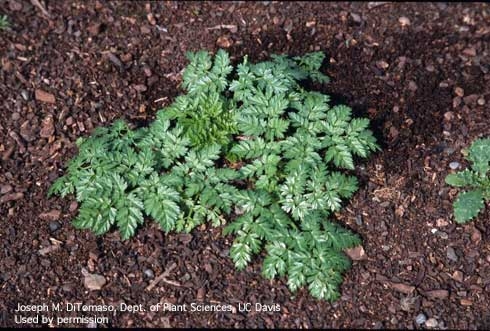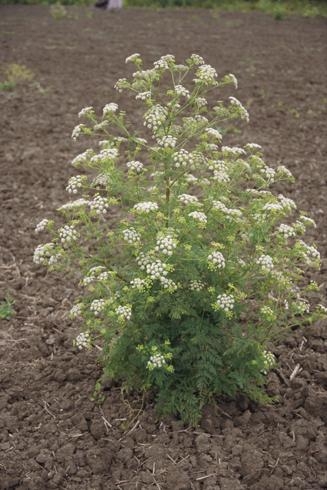- Author: Mary Louise Flint
-- Mary Louise Flint, Associate Director, Urban and Community IPM and Extension Entomologist

Poison hemlock, Conium maculatum, was brought from Europe into the U.S. as an ornamental in the 1880s and now occurs throughout North America. In California it is most commonly found at lower elevations and coastal regions but it is continuing to spread into other areas.
Although made famous by Shakespeare and other literary giants as a murder weapon, cases of human poisoning are rare in California; however, poison hemlock is a serious concern to the livestock industry. Cattle, goats and horses are most sensitive to the plant’s toxic alkaloids but pigs, sheep, elk, turkeys and wild animals may also be poisoned.
A new Pest Note: Poison Hemlock outlines identification, biology, impact and management for poison hemlock. It also includes a map of the weed’s distribution in California and areas where it is spreading. Poison hemlock is a biannual plant which grows as a low rosette in its first year and, in the second year, develops tall, up to 6 feet high or more, branching stems that bear small white flowers in spring through early summer.
Find the Pest Note: Poison Hemlock at http://www.ipm.ucdavis.edu/PMG/PESTNOTES/pn74162.html. Authors are J.M. DiTomaso, Plant Sciences, UC Davis; J.A. Roncoroni, UCCE Napa; S.V. Swain, UCCE Marin County; and S.D. Wright, UCCE Tulare/Kings County.





Could you please tell me what stage (how old) you think the poison hemlock is in your picture at the above link? It looks exactly like what I have in my yard. In my yard however, the stalk is so thin (about an 8th of an inch) and the sparse, leggy plant reaches 6 ft tall at the highest. At most, the stem that attaches to the tap root is less than an 8th of an inch and there is no rosette or fern-like leaves at the base. The leave are just like those pictured in your picture (sparse up the stems).
The seed pods are barbed and the stick to my clothes-- they are very hard to get off. Is this characteristic of poison hemlock seed pods??
Thanks for any information... I have two kids that eat the nystirtium nearby where I have found the suspect poison hemlock.
Hemlock is a biennial (takes two years to develop and reproduce). In year one it is usually low to the ground and just a clump of leaves. In year 2 it bolts and flowers. This plant is in its second year, http://ucanr.edu/blogs/MBMG//blogfiles/36264_original.jpg.
We are happy to help identify what you have in your landscape if you take several images of the plant and a close-up of the leaves. Email me directly at mgwomwack@ucanr.edu.
Melissa